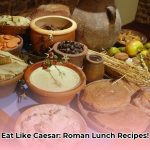Ever wondered what daily life tasted like in ancient Rome? Forget the lavish banquets depicted in movies, dripping with exotic fruits and roasted peacocks. For the vast majority of Romans, the diet was much simpler, yet surprisingly rich in nutrition and flavor. At the heart of this everyday cuisine stood a humble dish: puls. More than just a meal, puls was a fundamental part of Roman life, revealing much about their societal structure, agricultural practices, and culinary evolution. Interested in more roman food recipes?
This ancient grain porridge, often considered the ancestor of modern polenta or oatmeal, was the bedrock of the Roman diet for centuries before bread became widespread. It was an incredibly versatile and adaptable dish, serving as breakfast, lunch, or dinner, and could be prepared in countless ways to suit both the meager pantry of a farmer and the refined tastes of a patrician. Through a simple bowl of puls, you can connect directly with the past and experience a taste of true Roman antiquity, without needing a full-fledged archaeological dig in your kitchen.
What Was Puls? The Roman Superfood Unveiled
At its core, puls was a thick porridge made from various grains boiled with water or milk. While modern recipes often associate it with cornmeal, the Romans typically used barley (hordeum), spelt (far), or millet (milium). These grains were robust, easy to cultivate, and provided sustained energy, crucial for a largely agrarian society and its legionaries.
The preparation of puls was straightforward: grains were simmered slowly until they absorbed the liquid and reached a thick, creamy consistency. This simplicity made it accessible to everyone, regardless of social standing. For the poor, it was often eaten plain or with a drizzle of olive oil. For others, it became a canvas for more elaborate additions.
A Dietary Foundation: From Farm to Forum
Puls’s significance cannot be overstated. Before wheat-based bread became widely available and affordable, puls was the primary carbohydrate source for Romans. Early Roman writers, such as Cato the Elder in his agricultural treatise De Agri Cultura, mention puls as a staple for farm laborers, highlighting its critical role in sustaining the workforce. It provided essential calories and nutrients, laying the foundation for a strong and enduring civilization.
Its versatility also meant it appeared on diverse tables. While often associated with the plebeians and soldiers for its practicality and sustenance, even the wealthy enjoyed variations, enhancing it with honey, cheese, herbs, or rich broths. The famous gourmet Apicius, in his De Re Coquinaria, features recipes that incorporate meat and spices into grain-based dishes, demonstrating how elevated puls could become. This adaptability ensured puls remained a relevant and comforting food even as Roman culinary tastes evolved.
Recreating Puls Today: Your Kitchen Time Machine to Ancient Rome
Bringing puls into your modern kitchen is surprisingly easy and incredibly rewarding. It offers a healthful, comforting meal that connects you directly to the culinary traditions of one of history’s greatest empires. You don’t need obscure ingredients or specialized equipment; just basic pantry staples and a willingness to explore.
By making puls, you engage in a form of edible history. You gain an understanding of the simple, yet profound, dietary habits that fueled an empire. It’s a dish that emphasizes sustainability, local ingredients, and resourcefulness – principles that resonate even today.
Authentic Roman Puls Recipe (Savory Version)
This recipe is a reconstruction of a common savory puls, focusing on readily available ingredients for the modern cook.
Yield: 2 servings
Prep time: 10 minutes
Cook time: 30-40 minutes
Ingredients:
- 1 cup (200g) hulled barley (or spelt, farro, millet)
- 4 cups (950ml) vegetable or chicken broth (or water)
- 1 tablespoon olive oil
- 1 small onion, finely minced
- 2 cloves garlic, minced
- 1/2 teaspoon dried oregano
- 1/4 teaspoon ground cumin
- Pinch of black pepper
- 1/4 cup (25g) grated Pecorino Romano cheese (or Parmesan), plus more for serving
- 1 tablespoon fresh parsley, chopped (for garnish)
- Salt to taste (use sparingly if using salted broth and cheese)
Instructions:
- Rinse the Barley: Rinse the barley thoroughly under cold running water until the water runs clear. Soaking the barley for a few hours or overnight can reduce cooking time and make it creamier, but it’s optional.
- Sauté Aromatics: In a medium saucepan or pot, heat the olive oil over medium heat. Add the minced onion and cook until softened and translucent, about 5-7 minutes. Add the minced garlic, dried oregano, and ground cumin. Cook for another minute until fragrant, being careful not to burn the garlic.
- Combine Ingredients: Add the rinsed barley to the saucepan and stir to coat it with the oil and aromatics. Pour in the broth. Bring the mixture to a boil.
- Simmer: Once boiling, reduce the heat to low, cover the pot, and let it simmer. Cook for 30-40 minutes, or until the barley is tender and most of the liquid has been absorbed. Stir occasionally to prevent sticking and ensure even cooking. If it becomes too dry before the barley is tender, add a little more hot broth or water.
- Finish and Serve: Remove the pot from the heat. Stir in the grated Pecorino Romano cheese and black pepper. Taste and adjust salt if necessary. The puls should be thick and creamy, similar to a risotto or thick porridge.
- Garnish: Ladle the hot puls into bowls. Garnish with fresh chopped parsley and an extra sprinkle of Pecorino Romano cheese. Drizzle with a touch of extra virgin olive oil if desired.
Variations and Modern Twists
Puls’s adaptability is its greatest charm. Feel free to experiment based on your preferences:
- Sweet Puls: For a dessert or breakfast version, cook barley with milk or water, then stir in honey, chopped dried fruits (like dates or figs, popular in Rome), and nuts. A sprinkle of cinnamon or a touch of ricotta cheese can elevate this sweet rendition, reminiscent of Roman honey cakes like Libum or Savillum.
- Heartier Savory Puls: Incorporate cooked lentils or chickpeas during the simmering phase for added protein and texture. Sauté diced vegetables like carrots, celery, or leeks with the onion and garlic. For a truly Roman touch, a small amount of garum (fermented fish sauce) or a modern fish sauce alternative can be added during cooking for an authentic umami depth. Cooked shredded lamb, beef, or poultry can also be stirred in at the end.
- Herbaceous Puls: Experiment with other herbs frequently used in Roman cuisine, such as mint, rue (use sparingly, as it’s potent), or fresh coriander.
Embracing Simplicity: A Timeless Culinary Journey
Puls is more than just an ancient recipe; it is a tangible link to the everyday lives of Romans. It reminds us that good food doesn’t always require complexity or extravagance. By making this versatile and nurturing dish, you not only savor a unique historical flavor, but also gain a deeper appreciation for the culinary foundations that have shaped our tables over millennia. So, step into your kitchen, embrace the simplicity, and let the humble puls transport you across two thousand years of history.










